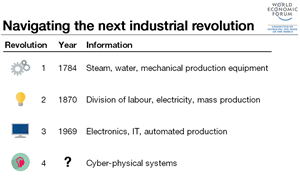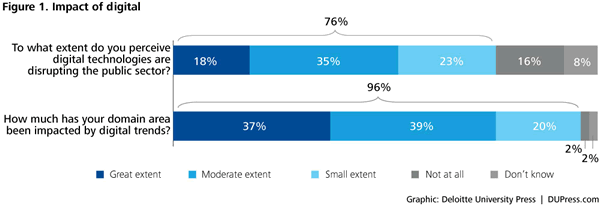
Across the globe governments and government agencies are implementing digital transformation projects and initiatives for a myriad of reasons, of which the satisfaction and experience of a changing citizen is one and cost savings another.
These transformations happen on all levels: national, regional, local, supra-national. They also happen in public sector services such as public transport/mobility and healthcare, across various government agency areas and in regulated and semi-regulated or state-sponsored services, which differ per country.
Ultimately, the ability of government systems and public authorities to adapt will determine their survival (Klaus Schwab)
Local and international drivers of digital transformation in government
Increasing efficiency and transparency, improving and aligning processes, smart government and smart cities, attracting new investors, bridging the digital divide, transforming government transaction services, data-driven government, better access to and management of information, enhancing citizen satisfaction and trust, meeting the needs of rapidly changing demographics and balancing costs while optimizing efficiency: it all plays a role in the ongoing digitization and digital transformation of government and the public sector.
The global and supra-national factor
Obviously, adapting to changing demands of a digital information age is not just driven by internal factors. In a global economy the ability to remain competitive requires digital and information excellence. In some countries this is even more the case as economies shift from their traditional income sources such as energy to revenue sources that are typical for service economies, as we for instance see in the Middle East.
The international dimension of digital transformations in government isn’t restricted to just economic shifts and necessities either. Organizations such as the EU and the OECD (Organization for Economic Co-operation and Development) call upon (member) states with regulations or recommendations to bring their governments closer to citizens as the OECD did in its ‘Recommendation on Digital Government Strategies‘.
The citizen experience is among the top drivers in digital transformation of government bodies as you’ll read below. That isn’t much of a surprise as it’s the equivalent of customer experience, which is a de facto key driver of digital transformation as in the end we’re all consumers, customers, citizens, patients and whatnot.
Digital government transformation in some countries
One country where recently more strategic initiatives and actions in the realm of digitization and digital transformation were taken, is Australia where in 2015 the Digital Transformation Office was launched. The first goal: creating a single digital identity to enable citizens to – digitally – access government services with one logon process.
Only 41 percent of surveyed public sector leaders are satisfied with their organization’s current reaction to digital trends
Another example is the UK where a digital transformation program was launched as mentioned in our article on the launch of the Digital Transformation Office in Australia. In February 2016, the UK government also announced a new advisory board to help shape its digital transformation and government digital services program with what it calls ‘digital heavyweights’. Something that is needed if you ask many observers.
In the US, the ‘United States Digital Service‘ is supposed to transform the way the federal government deals with citizens. Obviously that’s a big task in a big country with rather slow IT transformations but among the initiatives are programs to improve access to government information, Healthcare.gov and the modernization of the immigration system. End of 2015 the U.S. Census Bureau awarded a 5-year digital transformation contract to Accenture (mainly website) while several programs run on more local and specific levels.
A more recent evolution is that governments invest in initiatives, often in the sphere of boosting their digital agendas or as relaunch initiatives, go beyond regulations and the likes to boost digital transformation in the economy. A perfect example is the way the government of a Belgian region invests in a data-sharing initiative to accelerate innovation and transformation in both a public-private and private-to-private context as Barbara Van Den Haute, responsible for the data utility project, explained.
Digital transformation and the fourth industrial revolution in government
We could go on and zoom in on other countries and particular public services, from healthcare to public transport, but it’s clear that digital transformation ranks high on the agenda of many governments and government agencies.

It’s probably not a coincidence that at Davos 2016, the annual meeting of the World Economic Forum, the fourth industrial revolution (Industry 4.0) was omni-present, also in the context of government and of civil society.
As Klaus Schwab, Founder and Executive Chairman of the World Economic wrote at the occasion of Davos 2016, “As the physical, digital, and biological worlds continue to converge, new technologies and platforms will increasingly enable citizens to engage with governments, voice their opinions, coordinate their efforts, and even circumvent the supervision of public authorities“.
Yet, Schwab knows the risks too where he was quoted, saying that “We must develop a comprehensive and globally shared view of how technology is affecting our lives and reshaping our economic, social, cultural, and human environments. There has never been a time of greater promise, or greater peril.” Accenture CEO Pierre Nanterme was also quoted, saying that “digital is the main reason just over half of the companies on the Fortune 500 have disappeared since the year 2000”, but if you visit this site regularly you already knew that.
Government and public sector professionals on the state – and challenges – of digital transformation
Back to digital transformation, government and the public sector. Among the many top consulting firms, such as Accenture, fighting for a slice of the huge digital transformation pie is Deloitte.
Deloitte University Press looked at digital transformation in government and the ways challenges such as the aging population, the rise of millennials and budgetary issues, could ‘reshape the way government delivers services’, offering some advice and data on the journey that digital transformation of government (and of all ‘sectors’) really is.
In the infographic accompanying the article, Deloitte summarizes some key takeaways from its survey of more than 1,200 government officials, spiced with interviews of experts and government leaders. Let’s take a look at the key drivers of digital transformation in government and at how public sector workers, experts and executives see the need and evolutions regarding digital transformation according to the research and infographic which you find below.
According to the report, 53 percent of respondents perceive that digital technologies are disrupting the public sector to ‘moderate or great extent’. If we add the 23 percent that replied ‘small extent’ it adds up to 76 percent, leaving only 24 percent of respondents stating ‘not at all’ or ‘don’t know’.

Taking into account the number of countries (70) and the nature of the question (perceiving disruption which is not the same as seeing the potential of ongoing digitalization), let’s look at the core drivers: for 75 percent of respondents, cost and budget pressures and citizen demands respectively rank first and second, albeit with the obvious differences per country and per ‘domain’. Information and communication technology is the domain where digital trends impact is felt most, followed by education, transportation, international affairs and economic development. Also energy, social services, defense and healthcare rank high while law and justice and finance and revenue are least ‘impacted/disrupted’.
As the infographic shows, only 41 percent of surveyed public sector leaders are satisfied with their organization’s current reaction to digital trends which comprises improving processes, engaging talent and driving new and value-generating service models for citizens.
The infographic further classifies government organizations according to their digital maturity levels (all with their own challenges) and looks at some main hurdles and success factors.
This snapshot obviously is generic and doesn’t offer the full picture of the state and challenges regarding digital transformation in government. It doesn’t say anything about the opportunities and future perceptions nor about how the impact of a changing citizen, geopolitical evolutions and demographic shifts (ageing populations and digital natives and millennials about to enter government leadership) but let’s end with another quote from Klaus Schwab at Davos 2016: “Ultimately, the ability of government systems and public authorities to adapt will determine their survival”. And Schwab isn’t a millennial.

Top image purchased under license from Shutterstock

